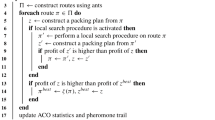Abstract
This study deals with the facility location-allocation problem with Euclidean distances and an unknown number of facilities. The problem is a harder variant of the NP-hard multisource weber problem where the number of facilities is known a priori. A worm optimization (WO) algorithm is developed for the problem, its parameters optimized using a custom design of experiments, and its performance assessed by comparing it to ant colony optimization (ACO) and genetic algorithms (GA). The extensive computational results showed that WO performed better than the other two algorithms in terms of both solution quality and convergence time, with ACO performing second and GA last.
Similar content being viewed by others
References
Aras, N., Orbay, M., & Altinel, I. K. (2008). Efficient heuristics for the rectilinear distance capacitated multi-facility Weber problem. Journal of the Operational Research Society, 59, 64–79.
Arnaout, J. P. (2018). Worm optimisation algorithm to minimise the makespan for the two-machine scheduling problem with a single server. International Journal of Operational Research, In Press.
Arnaout, J.-P. (2013). Ant Colony Optimization algorithm for the Euclidean location-allocation problem with unknown number of facilities. Journal of Intelligent Manufacturing, 24, 45–54.
Arnaout, J.-P. (2016). Worm optimization for the traveling salesman problem. In G. Rabadi (Ed.), Heuristics, meta-heuristics and approximate methods in planning and scheduling, international series in operations research & management science. Springer International Publishing.
Arnaout, J.-P. (2017). Worm optimization for the multiple level warehouse layout problem. Annals of Operations Research. https://doi.org/10.1007/s12351-017-0334-5
Arnaout, J.-P. (2020). A worm optimization algorithm to minimize the makespan on unrelated parallel machines with sequence-dependent setup times. Annals of Operations Research, 285, 273–293.
Arnaout, J.-P., Arnaout, G., & Khoury, J. (2016). Simulation and optimization of ant colony optimization algorithm for the stochastic uncapacitated location-allocation problem. Journal of Industrial and Management Optimization, 12(4), 1215–1225.
Bischoff, M., Fleischmann, T., & Klamroth, K. (2009). The multi-facility location-allocation problem with polyhedral barriers. Computers and Operations Research, 36, 1376–1392.
Bischoff, M., & Klamroth, K. (2007). An efficient solution method for Weber problems with barriers based on genetic algorithms. European Journal of Operational Research, 177, 22–41.
Brabazon, A., & McGarraghy, S. (Eds.). (2018). Worm foraging algorithm. In Foraging-inspired optimisation algorithms. Natural computing series. Springer.
Brimberg, J., Hansen, P., Mladenović, N., & Taillard, E. (2000). Improvements and comparison of heuristics for solving the uncapacitated multisource weber problem. Operations Research, 48, 444–460.
Brimberg, J., Mladenovic, N., & Salhi, S. (2004). The multi-source weber problem with constant opening cost. Journal of the Operational Research Society, 55(6), 640–646.
Carlo, H., David, V., & Salvat-Dávila, G. (2017). Transportation-location problem with unknown number of facilities. Computers & Industrial Engineering, 112, 212–220.
Cooper, L. (1963). Location–allocation problems. Operations Research, 11, 331–343.
Drezner, T., & Drezner, Z. (2016). Sequential location of two facilities: Comparing random to optimal location of the first facility. Annals of Operations Research, 246(1–2), 5–18.
Drezner, Z., Brimberg, J., Salhi, S., & Mladenovic, N. (2016). New local searches for solving the multi-source Weber problem. Annals of Operations Research, 246, 181–203.
Eilon, S., Watson-Gandy, C. D. T., & Christofides, N. (1971). Distribution management, mathematical modelling and practical analysis. Hofner.
Gamal, M. D. H., & Salhi, S. (2001). Constructive heuristics for the uncapacitated location-allocation problem. Journal of the Operational Research Society, 52, 821–829.
Houck, C. R., Joines, J. A., & Kay, M. G. (1996). Comparison of genetic algorithms, random restart and two-opt switching for solving large location-allocation problems. Computers and Operations Research, 23, 587–596.
Jabalameli, M., & Ghaderi, A. (2008). Hybrid algorithms for the uncapacitated continuous location-allocation problem. International Journal of Advanced Manufacturing Technology, 37, 202–209.
Krau S. (1997). Extensions du problème de Weber. PhD Thèse, Ecole Polytechnique de Montreal.
Kuenne, R., & Soland, R. M. (1972). Exact and approximate solutions to the multisource Weber problem. Mathematical Programming, 3, 193–209.
Liu, Q., & Xu, J. (2009). A study on facility location–allocation problem in mixed environment of randomness and fuzziness. Journal of Intelligent Manufacturing, 2011, 389–398.
Megiddo, N., & Supowit, K. J. (1984). On the complexity of some common geometric location problems. SIAM Journal on Computing, 13, 182–196.
Ohlemuller, M. (1997). Tabu search for large location-allocation problems. Journal of the Operational Research Society, 48, 745–750.
Pasandideh, S., & Niaki, S. (2010). Genetic application in a facility location problem with random demand within queuing framework. Journal of Intelligent Manufacturing, 2012, 651–659.
Reinelt, G. (1991). TSLIB-a traveling salesman library. ORSA Journal of Computing, 3, 376–384.
Salhi, S., & Gamal, M. D. H. (2003). A genetic algorithm based approach for the uncapacitated continuous location-allocation problem. Annals of Operations Research, 123, 203–222.
Weiszfeld, E. (1937). Sur le point par lequel la somme des distances de n Points donnés est minimum. Tohoku Mathematical Journal, 43, 355–386.
Author information
Authors and Affiliations
Corresponding author
Additional information
Publisher's Note
Springer Nature remains neutral with regard to jurisdictional claims in published maps and institutional affiliations.
Rights and permissions
About this article
Cite this article
Arnaout, JP., Khoury, J. Adaptation of WO to the Euclidean location-allocation with unknown number of facilities. Ann Oper Res 315, 57–72 (2022). https://doi.org/10.1007/s10479-022-04708-1
Accepted:
Published:
Issue Date:
DOI: https://doi.org/10.1007/s10479-022-04708-1




